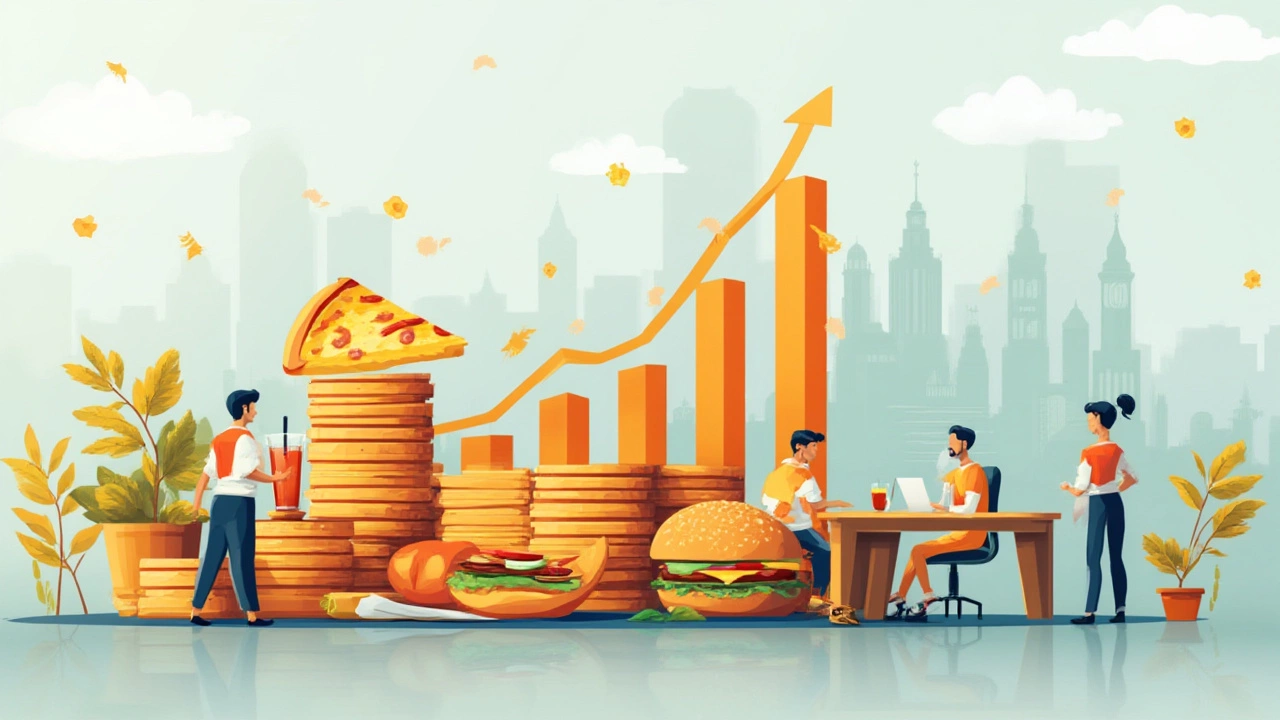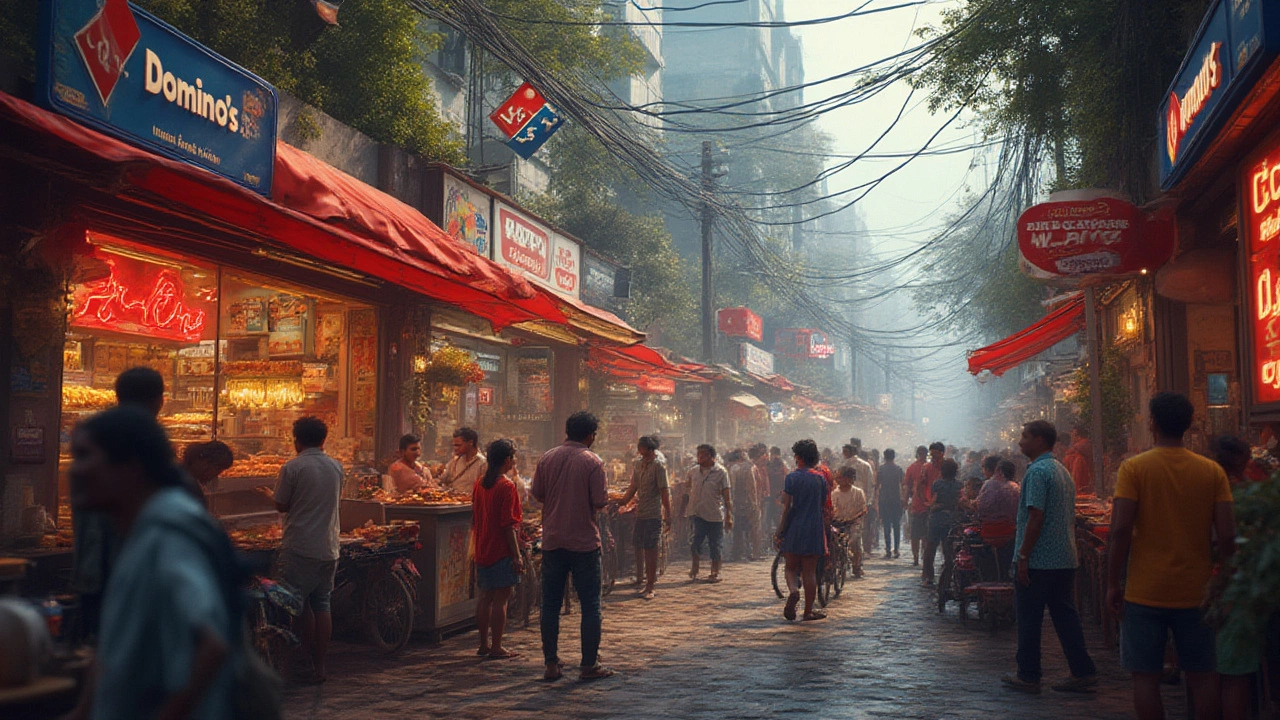If your LinkedIn feed is anything like mine, everybody seems to be opening a burger joint, pizza parlour, or those “grab-and-go” momo stalls. But here’s the real kicker: not all brands stacking up billboards are actually stacking up profits. There’s a serious difference between a crowded outlet on launch day, and a business that really pays you month after month. With India’s food service market expected to touch $95 billion in 2025, picking the right franchise has never been more make-or-break. So, which food franchise is actually most profitable in India right now? Get comfy, because the answers might surprise you.
The Fast Food Franchise Gold Rush: How Big Brands Dominate
Walk through any mall, and two things stand out: the aroma of fries and the fact that global brands have basically set up camp here. McDonald’s, Domino’s, and KFC didn’t just arrive—they invaded, adapted, and localised to an extreme. But is bigger always better for your wallet?
Let’s talk about hard numbers. Domino’s, operated by Jubilant FoodWorks, remains the largest and most profitable food franchise in the country. Their annual report consistently shows operating margins above 23%. On top of that, data from the Franchise India Expo (2024) estimates the average payback period (the time for an outlet to recover its investment) at just 2-3 years for Domino’s, compared to 3-4 years for QSRs like Subway or Pizza Hut. KFC sits close behind, but their costs per location tend to be higher, especially in premium mall spaces.
If you want to see the impact, check out the sheer number of Domino’s outlets—more than 1,800 across India by mid-2025. Their growth isn’t just quantity: their delivery-first model, local menu innovations (paneer pizza outsells pepperoni here), and relentless marketing mean their average daily footfall is nearly 300 orders per outlet. That’s wild considering the urban competition and the rise of local players.
Meanwhile, McDonald’s delivers similar scale but with higher setup costs. A typical McDonald’s outlet asks for upfront investments of around ₹2.5 crore, but the returns are proven. Franchisees report monthly sales topping ₹40-50 lakh in urban malls, with net profits usually in the 13-15% range after royalties—small percentage, big rupees. Subway is a unique story: lower costs (about ₹80 lakh – ₹1 crore), but also lower per-store earnings. If you’re aiming for lower investment but steady, predictable returns, Subway can work, though don’t expect fireworks on the balance sheet without prime locations and serious local marketing.
| Brand | No. of Stores (2025) | Initial Investment (in ₹ Lakhs) | Average ROI | Payback Period |
|---|---|---|---|---|
| Domino's | 1,800+ | 65-80 | 22-25% | 2-3 years |
| McDonald's | 350+ | 250-300 | 13-15% | 3-4 years |
| KFC | 700+ | 100-150 | 15-18% | 3 years |
| Subway | 600+ | 80-100 | 10-13% | 3-5 years |
Want the easy answer? Profitable food franchise India usually points to Domino’s. But scale isn’t everything—location, daily footfall, and supply chain make all the difference.
Indian Brands Punching Above Their Weight
So what if you want something desi and homegrown? Some of the best performers are local franchises fine-tuned for Indian tastebuds and urban growth stories. Two standouts: Wow! Momo and Chaayos. Wow! Momo’s journey blows my mind. It started as a college project in Kolkata, and now churns out crores in profit every month—yes, monthly. With over 1,000 outlets by 2025, you’ll find Wow! Momo in top airports, malls, and now, smaller urban clusters. Their setup cost can be as low as ₹20-25 lakhs for kiosk models, making them a hit for first-timers and semi-urban locations. Average monthly profit can hit ₹1.2-1.5 lakh for a mid-sized kiosk, once break-even hits.
Chaayos takes the tea café model and supercharges it with hippie-corporate interiors—think post-work meetings over masala chai. Setup costs are higher (₹50-75 lakh), but the per-store revenue among the strongest in the beverage-café game. Their USP is rapid menu innovation—40+ tea options, build-your-own-chai, seasonal snacks. As of July 2025, they boast over 250 outlets, with many urban franchisees reporting payback in about 2.5 years.
Now, Bikanervala and Haldiram’s are old-school heavyweights that quietly dominate high-margin snacks and sweets. Entry is tough (franchise opportunities are limited, and investments start north of ₹2 crore for full restaurants), but the profits, especially from festival sales and catering, are massive. Haldiram’s franchisees often report net profit margins of 17-22%—on much higher revenue numbers, given the scale of their outlets.
Here’s one under-the-radar tip—regional chains like Giani’s (ice-cream), Samosa Party, and Rollmaal are flying under the franchise radar. Their lower setup costs (as low as ₹15-30 lakh), single-product focus, and viral social media buzz mean they see much faster break-evens in smaller towns and college areas.
So if international isn’t your vibe or your capital is modest, these Indian originals are paving the way. Their main secret sauce? Relentless adaptation—seasonal menus, digital ordering, quirky collabs with Bollywood, and a no-frills approach to expansion. You get to ride the next hot trend wave before it peaks.

Profitability: The Nitty-Gritty Math and Hidden Costs
Anyone can flash return-on-investment figures, but let’s talk hidden costs that can eat your margins alive. Rent is your single biggest variable. Malls in tier-1 cities (Delhi, Mumbai, Bangalore) can eat up 20-25% of monthly sales in just rent. Add franchise royalties—5-9% of sales, depending on your brand. These are non-negotiable, and payable even in bad months. Then there’s labor. Staff salaries are rising at nearly 12% per year in urban centers, driven by competition and inflation. Training, uniforms, accidental damage—add another 1-2% in costs right there.
Inventory wastage is a sleeper problem. F&B outlets face 7-10% average wastage thanks to shelf life (think unsold bread, veggies), spoilage, and theft. Unless your brand has bulletproof SOPs for kitchen management—brands like Domino’s and Wow! Momo actually run regular audits using AI-powered POS—these costs can double quickly. With digital delivery now a huge sales driver (Swiggy, Zomato), commissions can wolf down another 15-25% of your billings. Ignore these, and you’ll find the ‘profit’ disappearing before it hits your bank.
How do successful operators keep margins healthy? Location is everything. High-footfall, low-rent areas—near colleges, major metro stations, or crowded markets—beat posh malls every day of the week. Go for a franchise operating a central kitchen (like Chai Sutta Bar), which can cut raw material costs by 15-20% by buying in bulk. Smart operators manage shifts and cross-train employees to keep labor lean but efficient. The best I’ve seen build tight relationships with suppliers, squeezing out bulk discounts that add up to lakhs each month.
Here’s a basic cheat sheet for monthly P&L (pre-tax, for a typical QSR in a top-20 Indian city):
| Revenue Item | Percent of Sales |
|---|---|
| Gross Sales | 100% |
| Rent | 14-20% |
| Labor | 13-18% |
| Ingredients/Inventory | 18-22% |
| Utilities/Maintenance | 4-6% |
| Marketing/Royalty | 7-10% |
| Delivery Commissions | 12-25% (variable) |
| Net Profit | 10-15% (best case) |
Keep these figures in mind when doing your business plan—you’ll always want a hard buffer for the first 6-9 months, as even big brands can have a slow takeoff if your location’s not on point.
Latest Trends and Insider Tips for Maximizing Franchise Profits
F&B is changing fast. Consumers now want quick service, Instagrammable setups, digital loyalty programs, and unique global-local mashups. Since 2023, the fastest-growing segment isn’t pizza or burgers, but specialty tea/coffee (like Chai Sutta Bar, Chaayos), regional snacks, and street food concepts driven by nostalgia and influencer marketing.
Franchisees who adapt win big. Checkout machines that take UPI, WhatsApp orders, and dark kitchens for pure delivery brands are quickly replacing legacy models. If you’re just getting started, consider a hybrid setup—one brick-and-mortar and a delivery-only kitchen (cloud kitchen) in neighboring areas. This combo can boost profits by 20-30%, sanitizing you from footfall dips during unexpected local events, weather, or even a new competitor on the block.
Here’s what top franchisees are focusing on right now:
- Digital-first ordering—apps or QR menus that sync with Swiggy/Zomato for zero missed orders.
- Loyalty programs using WhatsApp—most Indians now order repeat meals through one-tap reorders.
- Community influencer tie-ups—having a student or local celebrity promote your breakfast combo can beat a high-budget ad.
- Seasonal menus—think mango desserts in May, Diwali-themed mithai boxes in October. Seasonal hype = sales surge.
- Sustainable packaging—millennials care, and so do city governments. Go eco-friendly and get ahead of any coming fines.
One last thing: beware the “guaranteed profit” pitch. No franchise—even Domino’s or McD’s—can promise constant profits. What you should look for is proven support (training, site selection help), good tech integration (POS tracking, wastage control), and brand flexibility. Talk to running franchisees secretly—don’t just accept corporate numbers. Ask what their real take-home is, how often they get help, how long before their outlet hit break-even. The best franchisors want you to grow, not just lease their logo.
So, if you boil it down: Domino’s and KFC are hard to beat for pure scale and proven math. If you want more control, faster setup, or a trend-forward story, try Wow! Momo or a regional chain with lower capital needs and viral growth. Whatever your pick, remember—the real profit is in execution, location, and never letting your hustle drop after the opening month buzz.

